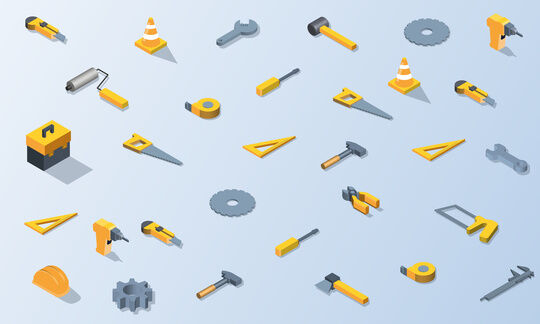10 Effective Ways to Enhance Web Accessibility

About 16% of people worldwide live with some type of disability. In addition to the permanent handicaps we all have in mind, this includes both temporary disabilities - like injuries that make it hard to move around - and disabilities that develop with age, like having trouble seeing clearly. When someone has a disability, it can make it harder for them to do things in their everyday life, including using the internet. The good news is that websites can be built in a way that makes them easy to use for everyone, especially when combined with helpful technology tools. However, many websites have problems that make them difficult or impossible for people with disabilities to use.
Making your website accessible to everyone can give you a real advantage over other websites. People with disabilities tend to keep coming back to websites that work well for them, and they often tell others in their community about these helpful sites. Plus, when you design your website to be accessible, it often leads to new ideas that make the website better for all users, which means more people will use and engage with your site.
These are some good reasons to make your website more accessible, and we'll look at 10 practical ways to do this.
Top 3 Reasons to Prioritize Web Accessibility
-
Social impact
Everyone should be able to use the internet, including people with disabilities. But when websites are hard to use, it limits what these people can do online. Making your website easy for everyone to use is the right thing to do, and it matters to customers - 70% of them want businesses to take action on social issues like this.
-
Economic opportunity
If your website is hard to use for people with disabilities, you could be losing business. Here's what research from the U.K.'s Click-Away Pound Report found: while more than 90% of people won't complain when they can't use a website, 69% of people with disabilities will simply leave and not come back if they find a website too difficult to use. This is a big deal because people with disabilities have $1.2 trillion to spend each year - that's a lot of potential customers to miss out on.
-
Legal compliance
Websites need to follow certain rules about accessibility, like WCAG, CCPA, and GDPR. In April 2024, the U.S. government made a new rule saying that state and local government websites must be accessible to everyone. While private businesses aren't required to follow these rules yet, courts are already using accessibility laws in lawsuits. Here are some examples:
- In June 2017, a blind person sued the Winn-Dixie grocery store chain and won because their website wasn't usable for blind people;
- Target had to pay $6 million in 2016 because they didn't add descriptions to their product images for blind users;
- In 2021, a judge ruled that Domino's Pizza broke the law because a blind person couldn't use their website;
These are just a few examples - the number of lawsuits about website accessibility has gone up by 75% from 2018 to 2022.
- Google Lighthouse extension (or PageSpeed)
- WAVE (Web Accessibility Evaluation Tool)
- Accessibility Checker
You can also check at the Visual Stability metric (CLS) of your Web Core Vitals with the Chrome developer tools, PageSpeed Insights and Search Console's Core Web Vitals report.
In this Core Web Vitals analysis of the top 10 CMS on the market, you can compare the performance and accessibility potential of each solution.
How Disabilities Can Impact Website Interaction?
Now that we understand why making websites accessible is important, let's look at how different disabilities can make it hard for people to use websites:
- Visual impairments: People who can't see well might need special tools that read the website out loud to them. Some people have trouble with colors - like not being able to tell red from green, or having a hard time reading light text on a light background. This means they might miss important information or buttons on a website if they're not designed carefully.
- Auditory impairments: People who can't hear well or at all won't be able to understand videos or audio on websites unless there's another way to get the information. This is why adding text versions, like captions for videos or written transcripts for podcasts, is really important.
- Motor impairments: Some people have trouble moving their hands precisely, which can make using a computer mouse difficult. They might need more time to click buttons or fill out forms, and very small buttons can be really hard for them to use. They also might need more time before a form automatically clears or resets.
- Cognitive and neurological impairments: Some people's brains process information differently. Things like flashing images can be very distracting or uncomfortable for them. They might find it hard to read long blocks of text without breaks, or they might get lost trying to find their way around complicated website menus. Breaking things into smaller, simpler pieces helps them use websites more easily.
10 Practical Tips to Make Your Website More Accessible
As more people use the internet, making your website accessible has become crucial. A secure web portal solution must include features that work for everyone. Here are 10 key website accessibility best practices that show you how to make a website accessible:
1. Make sure all sound and video has written text
Any sound or video on your web portal should come with a written version. This website accessibility features means adding captions to videos and writing out what's said in audio clips. This helps people who can't hear well, but it's also great for people who prefer reading or can't play sound at the moment, like when they're in a library.
2. Pick colors that are easy to read
Make sure your text is easy to read by using colors that stand out from each other. For example, dark text on a light background or light text on a dark background. The rules say text should be at least 4.5 times darker or lighter than its background. You can use simple online tools to check if your colors work well together.
3. Stop things from flashing on screen
Anything that flashes or flickers on your website can cause problems for some people, especially those who might get seizures. These effects can also be annoying for everyone else, so it's best to avoid them completely.
4. Make your content easy to follow
Website accessibility best practices include organizing your content like a book - with a clear title, chapters (H1), sections (H2), and subsections (H3, H4). This helps people using screen readers understand how your secure web portal solution is organized.
Ease of reading also depends on the level of language used. The use of “plain language” is therefore to be preferred for better content accessibility. Plain language is a writing technique aimed at making information easily understandable upon first reading, regardless of the reader's situation, education level, or age. It involves using simple words, short sentences, and a logical structure, thereby facilitating the comprehension and utilization of the presented information.
Implementing plain language on a website significantly enhances accessibility, allowing a broader audience, including individuals with reading difficulties or cognitive impairments, to easily find, understand, and use the information provided.
According to a study, 60% of readers take less than 30 seconds to fully read a text written in plain language, compared to 31% for a non-clarified text, indicating a notable improvement in reading speed.
Moreover, using plain language can strengthen trust between the information provider and the recipient, thereby enhancing relationships and reducing the risk of misunderstandings. By making web content more accessible, plain language contributes to inclusive communication and compliance with digital accessibility standards.
5. Keep your design clean and simple
A key part of how to make a website accessible is keeping your design clean and simple. Too many fancy features or complicated layouts can confuse people. A simple design helps everyone find what they need more easily.
6. Describe your images in words
Essential website accessibility features include giving every important image a short description (called alt text). This helps people who can't see the images understand what they show and helps search engines understand your web portal meaning better.
7. Label your forms clearly
For a truly secure web portal solution, make sure every form field clearly shows what information goes in it. Label things clearly like "First name" or "Email address." Also make sure people can move through the form using their Tab key.
8. Use better ways to stop spam
Website accessibility best practices include finding alternatives to traditional CAPTCHA puzzles that make you pick out traffic lights or type twisted letters, as these can be really hard for some people.
9. Make everything work without a mouse
Make sure people can use your whole website without a mouse. They should be able to get everywhere just using their keyboard (especially the Tab key). Try it yourself - if you can't reach something without a mouse, it needs to be fixed.
10. Give people enough time to fill out forms
A key website accessibility feature is allowing enough time for form completion. If your forms have a time limit, warn people before time runs out and let them ask for more time - at least 2 minutes more. This ensures your secure web portal solution works for everyone.
Make Your Digital Presence Accessible To Everyone
Making your website easy for everyone to use is really important - it's not just about following rules, it's about making sure everyone can use what you create. When you make your site easier to use, you help people with disabilities and make things better for all your visitors. A good DXP platform like Jahia is making it simpler than ever to build websites for everyone to use. By making these small changes today, you're helping create a web that works for everyone tomorrow.


